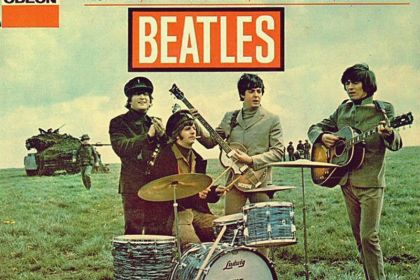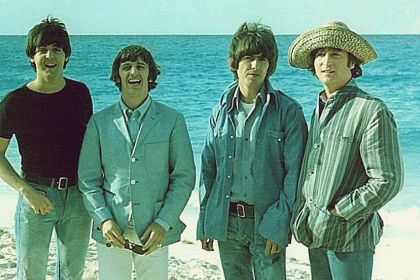Music Theory
50 Beatles songs using Ionian mode

The Beatles' A Doll's House album cover
It is widely known that the Ionian mode—often referred to as major mode—dominates other compositional methods in both classical and popular music. You can learn the structure of the Ionian mode explained with song examples in the article on 6 songs to unpack Ionian mode and the major scale.
The priority status of the Ionian mode is confirmed by our harmonic analysis of The Beatles' output. Indeed, out of 167 tracks penned by the band for their 13 official albums, we found 55 songs accompanied by Ionian chord progressions.
We have also identified about 80 Beatles songs that follow the canons of tonal theory as they show chord chains composed in six diatonic modes, namely the Ionian, Dorian, Phrygian, Lydian, Mixolydian, and Aeolian. That is, Ionian songs make up about 70 percent of all the Beatles' tonal-theory-oriented tracks.
One of the simplest yet very popular songwriting techniques involves three major chords of the Ionian mode and the Beatles adopted this approach in thirteen tracks. The harmonic structure of these songs is detailed in the article on Beatles songs composed with just three primary chords.
Here are 13 three-chord songs and their musical keys:
- All Together Now - G Ionian
- The Ballad Of John And Yoko - E Ionian
- Maggie Mae - G Ionian
- Rain - G Ionian
- Dig It - F Ionian
- Don't Pass Me By - C Ionian
- Why Don't We Do It In The Road? - D Ionian
- Baby You're A Rich Man - C Ionian
- Tell Me What You See - G Ionian
- She's A Woman - A Ionian
- You Can't Do That - G Ionian
- One After 909 - B Ionian
- Ob-La-Di, Ob-La-Da - B♭Ionian
The following list contains 23 tracks with more developed harmony. The chord progression of these songs combines minor and major chords of the Ionian mode as well as secondary chords that temporarily shift the tonal center:
- All You Need Is Love - G Ionian
- And Your Bird Can Sing - E Ionian
- Can’t Buy Me Love - C Ionian
- Carry That Weight - C Ionian
- Don’t Let Me Down - E Ionian
- Drive My Car - D Ionian
- Getting Better - C Ionian
- Good Night - G Ionian
- I Feel Fine - G Ionian
- I Should Have Known Better - G Ionian
- I've Just Seen A Face - A Ionian
- I Will - F Ionian
- In My Life - A Ionian
- I Need You - A Ionian
- The Inner Light - E♭ Ionian
- It’s All Too Much - G Ionian
- Let It Be - C Ionian
- Love Me Do - C Ionian
- Misery - C Ionian
- Not A Second Time - G Ionian
- Paperback Writer - G Ionian
- This Boy - D Ionian
- What You’re Doing - D Ionian
- Yellow Submarine - F♯ Ionian
- You're Going To Lose That Girl - E Ionian
In order to somehow diversify the light and cheerful sound of the Ionian mode, its scale degrees are subjected to alteration, with the lowered sixth degree being the most common. The lowering of the sixth degree by a semitone switches the Ionian diatonic scale to the harmonic major scale.
This technique can be seen in the nine tracks analyzed in the article on 9 Beatles songs that combine harmonic major with Ionian mode:
- I Saw Her Standing There - E Ionian
- Lucy In The Sky With Diamonds - A Ionian
- What Goes On - E Ionian
- Nowhere Man - E Ionian
- Any Time At All - D Ionian
- Across The Universe - A♭ Ionian
- All I've Got To Do - in E Ionian
- Ask Me Why - E Ionian
4 more Beatles tracks blend Ionian with other diatonic modes, a trick that sets different moods in adjacent song sections:
- Hey Jude - F Ionian / F Mixolydian
- I Want To Hold Your Hand - G Ionian / G Mixolydian
- Octopus’s Garden - E Ionian / E Mixolydian
- There’s A Place - E Ionian / E Lydian
Finally, there are 3 songs showing the Ionian mode in the verses while the rest of the song's chord chains do not follow any diatonic mode:
- No Reply - F Ionian
- Only A Northern Song - A Ionian
- Two Of Us - G Ionian
Explore how The Beatles use other musical modes in our articles:
- Beatles songs featuring Lydian mode
- 9 Beatles songs that combine harmonic major with Ionian mode
- Beatles songs with Dorian mode
- Beatles songs with harmonic minor and Aeolian modes
- Things We Said Today: the only Beatles song featuring Phrygian mode
- Golden Slumbers: lyrical origins of the famous Beatles lullaby
- Picardy third: cadence for a happy ending in classical music and popular songs
- Beatles songs composed with just three primary chords
Discover more songs composed in Ionian major mode and check out their harmonic analysis in the following articles:
- 6 songs to unpack Ionian mode and the major scale
- 9 Beatles songs that combine harmonic major with Ionian mode
- Longfellow Serenade and the fireside poet that kindled Neil Diamond's song
- Wildwood Weed: the cheeky ganja farmers song that got banned
- Sugaree: Jerry Garcia's song referencing his lyricist's criminal past
- D'yer Mak'er: meaning of Led Zeppelin's most controversial song
- Seven Seas of Rhye: song of imaginary land brought to life by Ionian and Mixolydian modes
- Coal Miner's Daughter was forced to remove a third of the lyrics from her autobiographical song
- I Wanna Be Sedated: pure classical harmony cementing the Ramones' hit in punk rock history
- Hasta Mañana: the origins of the best ABBA ballad



